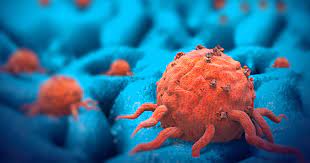Cancer

Cancer starts from the uncontrolled division of cells in the body. As the abnormal cells continue to grow, they form a tumor. As the tumor grows it can metastasize, or spread, and begin forming new tumors in different parts of the body. Not all cancers behave the same way; different types of cancer have different growth rates and respond differently to anti-cancer treatments. In medical terms, cancer is referred to as malignant neoplasms.
Why it's important
Cancer is the second leading cause of death in the United States. One in three women and one in two men will be diagnosed with cancer at some point during their life. Prevention, screening, and treatment options are available for most types of cancer and their use and advancements in each have decreased death rates due to cancer.What is known
Cancer generally develops over several years and has many causes. Several factors both inside and outside the body, contribute to the development of cancer. Some of these factors include genetics, tobacco use, diet, weight, physical inactivity, and excessive sunlight exposure. Other factors include exposure to chemicals that may be present in food, air, or water such as asbestos, benzene, and arsenic.What is known
Nobody is immune from getting cancer. Although scientific studies have identified specific factors which increase the risk for cancer, sometimes people without any risk factors still develop cancer and people with many risk factors do not develop cancer. The following list contains common cancer risk factors.- Older age; the risk of developing cancer increases with age
- Race and ethnicity; people of certain races and ethnic background are at higher risk for certain types of cancer
- Tobacco use
- Certain environmental exposures
- Genetics and family history
- Certain medical conditions/diseases such as a weak immune system, diabetes, Crohn's disease, or human papillomavirus (HPV) infection
How to reduce the risk
There are many ways to reduce your risk for cancer. Following these guidelines will not only reduce your risk for cancer, but improve your general health as well:- Maintain a healthy weight
- Exercise regularly
- Do not smoke; if you already smoke, look for ways to quit
- If you drink alcohol, drink only in moderation
- Receive proper immunizations; certain infectious diseases like the human papillomavirus (HPV) and Hepatitis B and C could lead to cancer later in life
- Protect your skin from the sun; wear proper sun-protection clothing and use plenty of sunscreen when you are outside
- Limit your exposure to environmental risk factors, such as asbestos, radon, arsenic, and benzene
- Get regular medical check-ups, including cancer screening tests like mammography, Pap test, and colonoscopy. Early detection of cancer significantly improves the chances of a complete recovery.
How it's tracked
Cancer data come from several sources:- Screening: The Behavioral Risk Factor Surveillance System (BRFSS) monitors the use of preventive screening for a variety of cancer types such as mammography to detect breast cancer, Pap tests for cervical cancer, colonoscopy for colorectal cancer, and PSA tests for prostate cancer.
- Incidence, stage at diagnosis, and survivorship: State cancer registries collect detailed information about cancer patients and the treatments they receive, which makes the monitoring of trends in incidence and mortality as well as the evaluation of prevention and control measures possible.
- Mortality: Death certificates are a fundamental source of demographic, geographic, and cause-of-death information. They make it possible to track every death in the nation due to cancer. Deaths are reported as being due to cancer when the cancer was the underlying cause of death.
Cancer Incidence
- Bladder Cancer
- Breast Cancer Incidence
- Cancer of the Brain and Central Nervous System
- Cervical Cancer Incidence
- Colon Cancer Incidence
- Hereditary Breast and Ovarian Cancer
- Leukemias
- Lung Cancer Incidence
- Lynch Syndrome (Cancer)
- Melanoma of the Skin Incidence
- Non-Hodgkin Lymphoma
- Prostate Cancer Incidence
Cancer Screening/Prevention
- Breast Cancer - Mammography
- Cervical Cancer Screening (Pap)
- Colorectal Cancer Screening
- Immunizations - HPV, Adolescents
- Prostate Cancer Screening
Cancer Deaths
Cancer Incidence
Mortality: Cause of Death - NCHS 50 Leading Causes: Malignant neoplasms
Cancer - Adults (BRFSS)
- Diagnosed With Skin Cancer - Crude Rates
- Diagnosed With Skin Cancer - Age-adjusted Rates
- Diagnosed With Other Cancer Besides Skin - Crude Rates
- Diagnosed With Other Cancer Besides Skin - Age-adjusted Rates
Cancer Screening - Adults (BRFSS)
- Mammography (Women 40+) - Crude Rates
- Mammography (Women 40+) - Age-adjusted Rates
- Clinical Breast Examination (Women 40+) - Crude Rates
- Clinical Breast Examination (Women 40+) - Age-adjusted Rates
- Pap Test (Women 18+) - Crude Rates
- Pap Test (Women 18+) - Age-adjusted Rates
- Sigmoidoscopy or Colonoscopy (Adults 50+) - Crude Rates
- Sigmoidoscopy or Colonoscopy (Adults 50+) - Age-adjusted Rates
- Recommended Colon Cancer Screening (Adults 50+) - Crude Rates
- Recommended Colon Cancer Screening (Adults 50+) - Age-adjusted Rates
- Prostate-Specific Antigen Screening (Men 40+) - Crude Rates
- Prostate-Specific Antigen Screening (Men 40+) - Age-adjusted Rates
- Discussed Advantages of PSA Testing With Dr (Men 40+) - Crude Rates
- Discussed Advantages of PSA Testing With Dr (Men 40+) - Age-adjusted Rates
- Discussed Disadvantages of PSA Testing With Dr (Men 40+) - Crude Rates
- Discussed Disadvantages of PSA Testing With Dr (Men 40+) - Age-adjusted Rates
Skin Cancer Prevention - Adults (BRFSS)
- Sunscreen Use - Crude Rates
- Sunscreen Use - Age-adjusted Rates
- Sun Safety - Crude Rates
- Sun Safety - Age-adjusted Rates
Skin Cancer Prevention - Adolescents (YRBS)
Resources
- Cancer topic page from Environmental Public Health Tracking (includes list of Utah Cancer Studies)
- Cancer In Utah: An Overview of Cancer Incidence and Mortality from 1973-2010 - Utah Cancer Registry
- Comprehensive Cancer Information - National Cancer Institute
